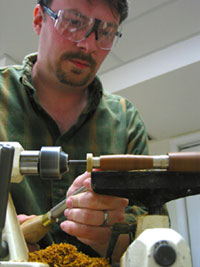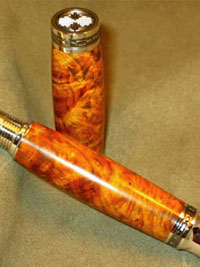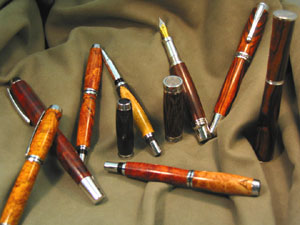Chris Higdon: Extraordinary Writing Instruments
by Doug Hall & Elena Vega
 Doug Hall:
I have visited your website and your work is absolutely incredible. How long have you been turning?
Doug Hall:
I have visited your website and your work is absolutely incredible. How long have you been turning?
Chris Higdon:
About 4 years. My wife and I bought my dad some turning tools to go with a lathe my mom bought him for Christmas. We took a turning class at Highland together and I fell in love with turning and he didn’t. He chose to go back to the woodworking he has always loved (doll houses and furniture) and I ended up with the lathe and a new obsession.
DH:
Did you start with pens or other items?
CH:
Interestingly enough I started with bowls and hollow forms and initially did not have an interest in pens. I started getting very interested in very rare, unusual and highly figured woods. Getting these woods the size needed for bowls was either unavailable or too expensive so I tried with some pens. Once I saw where you could go with it I was hooked.
DH:
What pen did you begin with? I know that Frank Bowers, one of the turning instructors here at Highland Woodworking, likes to start students on the 7mm 24kt Comfort Pen.
CH:
I started with the 7mm as well and it is a natural choice for a beginner. I quickly moved away from it once I saw the quality options that were out there. There are so many quality pen components available now and the trend is going more and more to high end/high quality.
 Elena Vega:
Do you create your pens with a hardware style (pen kit design) and wood already in mind, or does the way the wood grain, color, etc. emerge as you turn a piece dictate the pen it will become?
Elena Vega:
Do you create your pens with a hardware style (pen kit design) and wood already in mind, or does the way the wood grain, color, etc. emerge as you turn a piece dictate the pen it will become?
CH:
Both. There are certain types of woods or grain orientations that I particularly like with certain styles and there are other woods that work well with any pen style. A lot of my selections are geared towards certain people. A certain amount of my pens are custom.
DH:
Do you make your own blanks?
CH:
Yes and no. I get a lot of blanks that are already cut, but many of them I cut to size from larger pieces. Some pieces, particularly burls, can take a lot of preplanning before cutting to get the best grain and minimize expensive waste.
EV:
Do you use any materials other than wood for your pens?
CH:
I definitely use woods or natural materials for most of my pens. There are some great synthetic materials out there in the form of acrylics and celluloids but I have not done much with them to date. I have used some other materials including the skeleton of a cactus cast in clear and colored resins for instance. These have been very popular.
 EV:
Do you have a favorite wood? If so, why is it your favorite?
EV:
Do you have a favorite wood? If so, why is it your favorite?
CH:
That is a hard choice. I tend to personally like a very curly or quilted wood with a lot of chatoyancy but burls are very popular and hard to beat. I also love very rare woods with great stories but they aren’t always the most attractive. I guess my favorite would have to be Chittam Burl. It has the chatoyancy I love, the burled figure, an unusual color (gold/yellow/orange), and is one of the rarest burls in the world. And unlike the other super rare burls that are pulled out of the jungle by elephants or buried under the ground in Morocco, Chittam Burl comes from Alabama and still most people don’t know about it.
DH:
What type of workshop setup do you have?
CH:
It is not a large shop; it is strictly a turning workshop with a couple of lathes, a couple of drill presses, and a couple of bandsaws with a finishing/assembly bench. There is a fair amount of pen blank storage and of course there is a TV, radio, and refrigerator.
DH:
To do this properly, how much space do you think is necessary? Can someone without a "real" workshop turn pens?
CH:
I know people who do. I first worked in the garage and would sit on the hood of my car to take a break without leaving my lathe. I have seen other shops that weren't much more than converted closets, so it takes less room than almost any other type of woodworking. If you stick to pens you can definitely do this in small spaces with minimal mess.
 DH:
What type of turning tools do you use for turning pens? After all, it is very small and detailed work.
DH:
What type of turning tools do you use for turning pens? After all, it is very small and detailed work.
CH:
Interestingly enough I use large tools for more stability. I personally prefer
Glaser tools
as they are more stable than anything else I have found. My favorite tool is actually a 1 ¼” roughing gouge. It is a surprisingly versatile tool and I am anxiously and hopefully waiting for Glaser to make one.
DH:
Tell us a little bit about how you manage the work flow when you turn pens. Do you work in batches, production-style, or do you complete each pen one at a time?
CH:
It is production style to some degree. I tend to work in batches of ten to twenty which helps with the efficiency but keeps it fun. It is primarily in three phases for me. First I drill and glue barrels and square the ends in batches. After that I turn and finish each pen before removing it from the lathe. Once that batch is done I assemble the pens.
EV:
What type of product and process do you use to finish your pens?
CH:
There are four finishes out there that are durable enough for pens in my opinion: CA glue, lacquer, Enduro poly, and a homemade Plexiglas finish. CA is my preference. I use
thin Hot Stuff CA Glue
for my finishes which I build up about five coats on a moving lathe and polish down to 12,000 grit micromesh followed by a plastic polish. It creates a high gloss finish that is very durable.
 EV:
Judging from your
website
, you have quite a pen business. Is it your fulltime job?
EV:
Judging from your
website
, you have quite a pen business. Is it your fulltime job?
CH:
It feels like it some of the time but it is not my fulltime job. I have a degree in Landscape Architecture and am with an Atlanta firm called Scapes high end residential landscape design and construction.
EV:
How did you start selling your pens?
CH:
Like most people of course, I started selling them around the office and to people I knew. Before long my family and friends started showing them to other people and it took off from there. Now my business is split between corporate sales,
retail
, as well as word of mouth of course.
EV:
Your pens seem to have a very distinguished, elegant, masculine look to them. Do you sell mostly to men?
CH:
I would say that most of my pens do go to men but I definitely sell a good number to women as well. There are a couple of styles that are definitely unisex and then there are styles that are used by men much more.
DH:
What advice would you give someone who was inspired by your pens and decided they wanted to try pen turning? Do you recommend classes, or are there books or tapes or DVD’s that you think are good resources?
CH:
If you haven’t turned before I recommend lessons first no matter what. I would say starting with a basic turning class or lesson is a good idea so you can understand the lathe and the proper mechanics of turning first. If you are in Georgia or close by then
Highland’s classes
are very good. Join a local woodturning club if you have one. For pen turning especially visit the
International Association of Penturners (IAP) website
. This group is a very good resource and has helped me tremendously. If you are already a turner then start off with some scrap wood that you don’t mind blowing apart and get started. You can always start with some inexpensive kits but eventually you will want some better parts with longer lasting finishes.
Chris Higdon resides in Marietta, Georgia, where he lives with his wife, Taylor, and daughter, Evelyn. He may be contacted through his website:
www.higdonpens.com
.
View a gallery of Chris Higdon's work